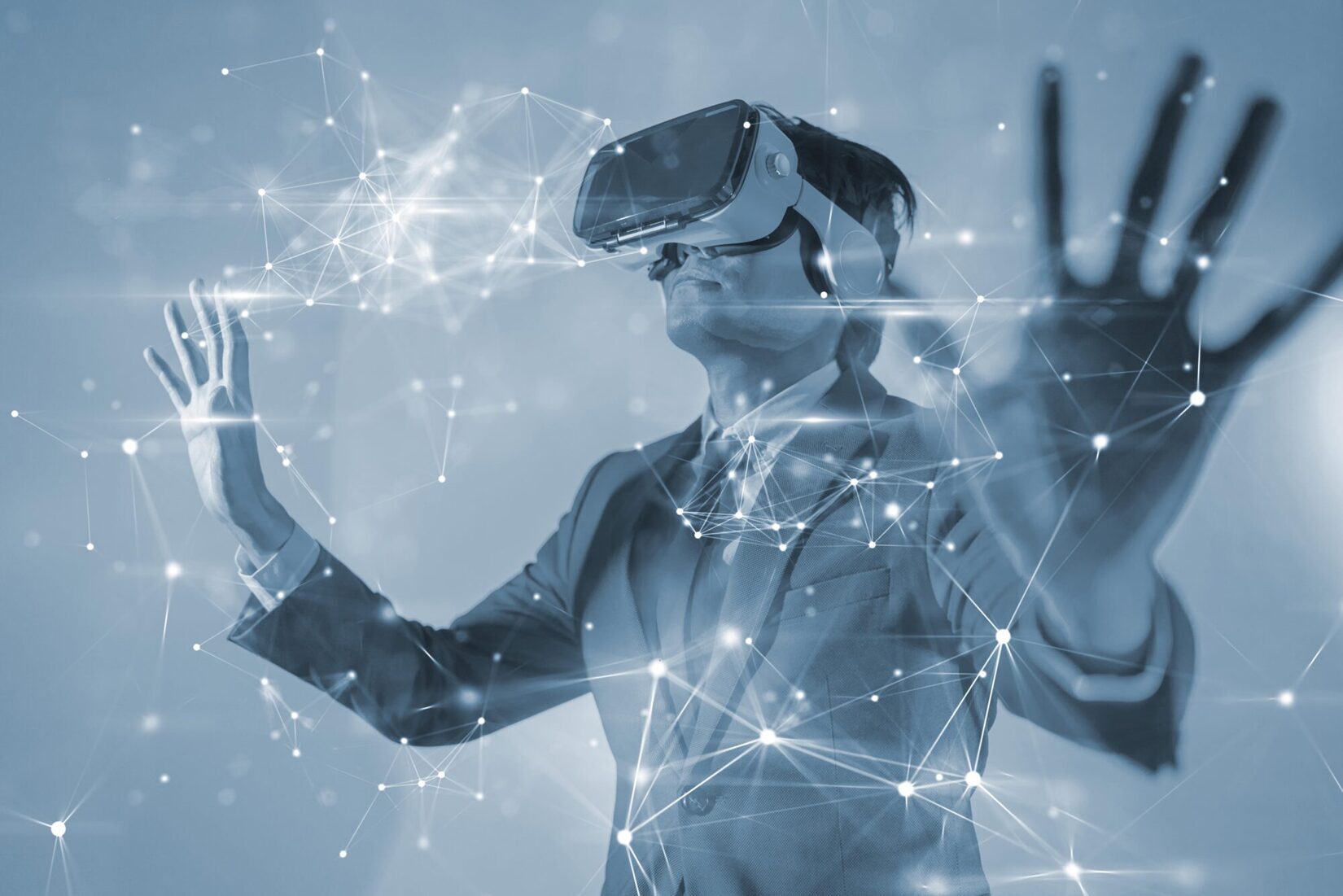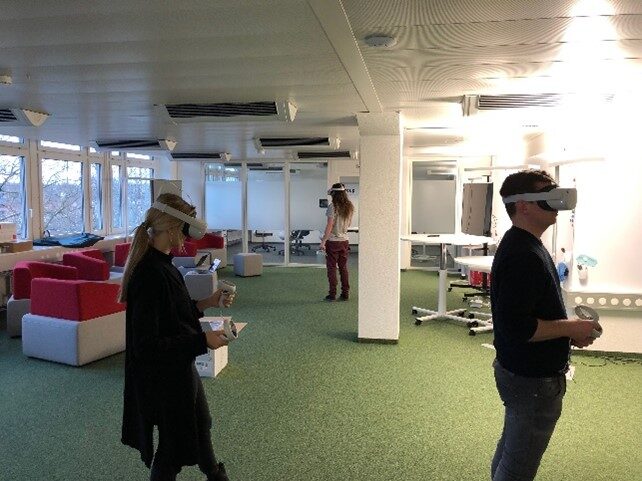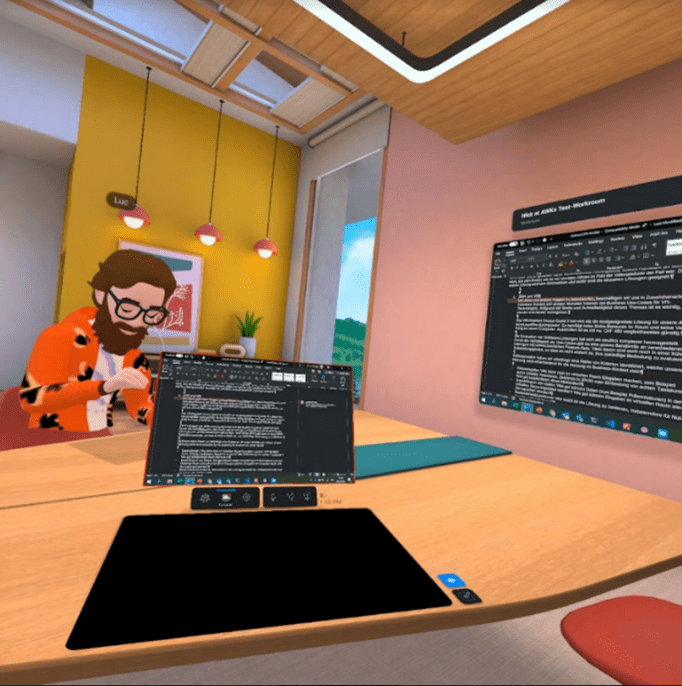
Our VR team: Nicolas Klose, Paul Montague, Luc Dobler, Max Schrimpf, Lukas Möller, Roger Pollini and Annika Geissler have tested current VR solutions together and are happy to present the results in this blog entry.
At this year's Consumer Electronics Show (CES), there was one overwhelming topic: the Metaverse! At the latest since Facebook has brought the topic into the public eye by renaming it "Meta" and its enormous broad impact, various companies are jumping on the topic and presenting their own ideas what the otherworldly universes of the future will bring. It is not only about immense prices for virtual properties and a virtual gaming landscape but about the creation of virtual realities that interact or even compete with the "analog world".
Once before, the world experienced what it means when millions of people start moving simultaneously in a virtual parallel universe. With the release of Pokémon-Go in June 2016, people flocked, for reasons completely unrecognizable to outsiders, to places where rare Pokémon appeared or engaged in battles over virtual arenas in monuments. The clash of the virtual universe on the smartphone and the everyday environment already represented the attraction for many people at that time.
At the same time, it is not new for people to meet and experience virtual realities. At the latest since the World of Warcraft, massively multiplayer online role-playing games (MMORPGs) have become an integral part of the computer games industry, delighting millions of people around the world every day.
The ideas surrounding the current metaverse go one step further. Instead of a reality on the computer screen as in MMORPGs or augmented reality of Pokémon-Go, they bring us into a fully tangible virtual reality, which is best experienced with an appropriate headset. Depending on the solution, you can move freely in virtual space.
It has been impossible to imagine the gaming industry and the pictures from Gamescom without VR glasses for years. Numerous VR headsets have found their way into the homes of passionate gamers so that every new game can be played. Compared to solutions in the industrial environment, business is lagging far behind in our experience there, where the standard introduction of video conferencing in everyday office life (and creating the technical basis for it) was only anchored in the entire working world by a global pandemic.
After the pandemic, a new normal has been established at many companies with office operations, with greater flexibility and the ability to work from anywhere. Meetings take place virtually - whenever possible - to be compatible with home office and workation. Various methods, such as the use of Miroboards and Mentimeter, have taken hold to streamline virtual meetings, and in some cases offer advantages over traditional on-site workshops. However, we have found that these online meetings have technical limitations and, most importantly, they tempt people to pursue other activities at the same time, which means that even we as a "digitalization company" still strongly advocate on-site workshops in certain situations.
However, on-site meetings need to be planned well in advance, as travel is now considered extraordinary. Thus, the newfound flexibility makes it more difficult to find shared time slots for creative workshops or other forms of intensive on-site collaboration.

We tried it out - and were "flashed" when we used the VR glasses for the first time. One minute you're sitting at your desk in the office, at home, or in a faraway country, and the next you're putting on the VR glasses and finding yourself in a collaboration environment that doesn't miss a beat:
- Do you need an (additional) whiteboard? Can you conjure it up.
- Do you want to share a presentation? It's visible to everyone with just a few clicks.
- Is there not enough space left? In a few moments you can beam into a new room and take everything with you.
You interact by using your hands, turning your head and moving around in the virtual environment. Often controllers for the hands are used, which offer some buttons for certain actions, like bringing up a virtual display.
After the first walking attempts in this virtual world, we could imagine doing creative workshops there more often in the future. We see training or immersive sessions of globally distributed boards as other possible application areas. As an important aspect we see the full concentration on the current meeting, because in contrast to the normal video meeting, one is not distracted by other windows, but the meeting prevails in a 360° view.
And the possibilities in industrial activities are quite different, like moving inside a digital twin of a factory or learning the operation of a machine. From our point of view, it makes no sense for normal coordination meetings, since an unnecessarily large overhead is created by the set-up.
It is therefore not without reason that a wide variety of VR offerings, both hardware and software, are sprouting from the ground, as was the case in the field of video telephony a few years ago. But which solution will prevail and what are the individual solutions suitable for?

To answer these and other questions, we have been working intensively with several customers on business use cases for VR technologies for several months. Due to the breadth and fast-moving nature of this topic, it is important to take an exploratory and iterative approach.
The Oculus Quest 2 VR headset has emerged as the most suitable solution for our use cases. It requires no extra sensors in the room and no connection to a computer. It is also comparatively inexpensive at around CHF 400.
The evaluation of software solutions turned out to be much more complex. Due to the diversity of business use cases, there is a wide range of different solutions with different feature sets. Many of these are also still at an early stage of development, so it is not easy to evaluate their future relevance.
In the end, however, we have identified a number of criteria that we believe are critical for use in a business context:
- Data input: how can input be made in virtual space, for example through virtual keyboards, drawing in 2D/3D, or incorporating real keyboards? How well do these methods work?
- Import/export of data: How well can data (for example, presentations) be imported into the virtual space? How well can inputs in the virtual room be re-exported?
- Usability/Learning curve: How easy is the solution to use, especially for users without VR experience?
- Access without headset: Is it possible to join the virtual room without a headset?
- Movement options: How can one move around in the virtual space?
We have looked in depth at three solutions so far: MeetinVR, Horizon Workrooms and AltSpaceVR. MeetinVR has been around for a few years and is being developed by a small company. Horizon Workrooms, on the other hand, is the fairly new business VR solution from Meta (formerly Facebook), and AltSpaceVR is an established solution purchased by Microsoft in 2017.
MeetinVR allows free movement around the room. There is a virtual keyboard that is a bit bulky to use. Drawing is possible both 2D on whiteboards and 3D in space. 3D drawing is an interesting experience, as this is only possible in virtual space. Whiteboard content can be imported and exported. The operation partly requires some getting used to, especially if you have little experience with controllers. Access without a headset is possible via a desktop application, but only with limited interaction options.
In Horizon Workrooms, you are tied to a physical desk, which is simulated virtually, or to a virtual whiteboard. Data entry and import/export are very simple. With the help of a desktop application, the content of a computer screen can be virtually displayed live. So you can use a real keyboard and mouse and have direct access to your work. In our opinion, this feature currently lets Workrooms outperform the competition. The operation is also more intuitive, for example, when drawing on a whiteboard. Almost everything can be done with hand gestures instead of controllers. Access is possible directly via the browser.
AltSpaceVR behaves similarly to MeetinVR and also allows free movement in the room. The virtual keyboard also takes some getting used to here. You can create a lot of interaction with the Microsoft world and integrate elements like whiteboards or MS Teams meetings. You also have to be a bit patient here for the operation with controllers. Especially when moving to other places in the room, the "beaming", you can also quickly get a little dizzy. Access without a headset is just as possible via an MS Teams Call.
Since new solutions appear on the market almost daily, we as the DWP team regularly test new approaches together, especially Spatial, Glue, Engage, and Arthur. We are excited to see how these solutions compare to the top three.
As mentioned above, the solutions are not only tested at Eraneos Group, but also in collaboration with customers. Together, we hold workshops to share our findings, try out the technologies and identify further potential together.
In addition to the above-mentioned benefits, especially the enthusiasm, there are other advantages, such as the noticeable complete presence in the workshop - there's no chance that I'll be doing mails at the same time. But also the feeling of togetherness: being together in one room even though we are globally distributed. The interpersonal interaction makes you feel realistically close to the other participants. You can also quickly create inspiring, innovative moments. At the end of the workshop, you conjure up fireworks or a giraffe. Things that would not be possible in an on-site workshop.
When it comes to virtual reality, visions of the future are inevitable. Together we considered: How could VR continue to develop in business? We are certain of one thing: VR technology will not simply disappear again. Why do we believe this? On the one hand, it shows us the investment of the big technology companies in VR, on the other hand, we see great opportunities for the "New Way of Working". Not to forget the financial and sustainable advantage that an on-site presence is no longer necessary and that I can avoid a plane trip, for example. In part, these possibilities are already visible today, as in the use of VR glasses for innovative workshops, but above all we still see great potential for innovation and optimization, whether in the design of the glasses or in the configuration of the metaverse. This could still contribute to one of the biggest changes in the current way of working.
If we take our visions further, one of our future scenarios is to have VR glasses on every workstation in the next few years, and that will then be as natural as our headset, mouse or keyboard is today. If we choose a disruptive approach, even screens in offices could disappear completely and the workspaces as we know them today could change in a revolutionary way. Then our office will be more like a cozy lounge where people meet for a coffee and wear their VR glasses in comfortable armchairs for three to four hours until they want to quickly meet up with Ms. Müller at the real coffee machine.
You can already experience part of this vision of the future today: We are already conducting workshops with some of our customers to experience and use the immersive experience together. For this, we are also happy to meet with you once in a metaverse of your choice. We as the entire Digital Workplace Team at Eraneos will definitely continue to try out the solutions and see what is already a reality in our dreams, so that Virtual Reality becomes a reality in business.
What new capabilities and skills are needed to build a corporate IT that accompanies and actively drives innovation as part of corporate value creation?
Eraneos Labs
The fun factor for projects, topics and competence building.
Scale Wars | Die Grenzen des Ethereum-Netzwerks
The number of users of blockchain applications has increased dramatically in recent years. This article highlights the need for scaling solutions and looks at some of the possible approaches.
News & Eraneos Insights
We have compiled reports on our projects, interesting facts from the various competence and customer areas as well as information about our company for you here.
